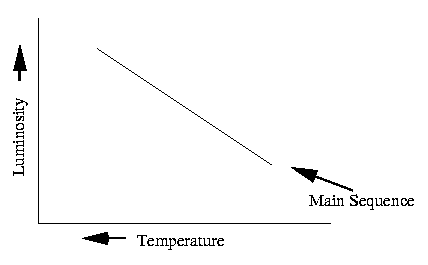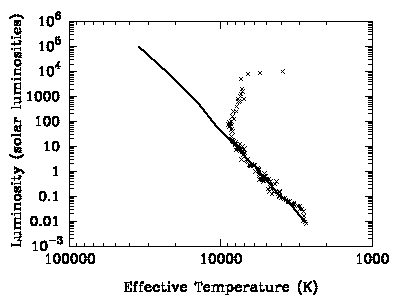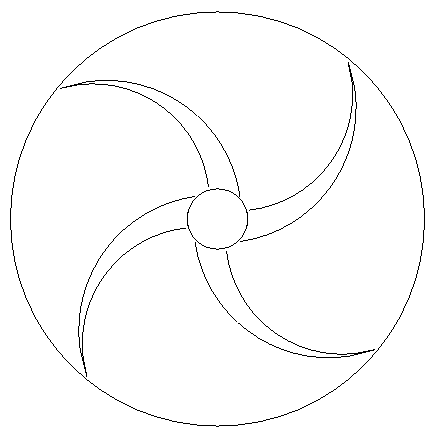BUCKNELL UNIVERSITY
Astronomy 102
Second Hour Exam
|
1998 April 15
|
This Exam will be scored on a 100 point scale and has two parts:
a multiple choice/fill-in section of 10 questions worth a total of 40 points
and
a problem section with 3 problems, each worth 20 points.
Here are some quantities and relationships that you might find useful:
Multiple Choice Questions:
1) How many neutrons are in one nucleus of
83Bi209?
- a) 0
- b) 1
- c) 83
- d) 126
- e) 209
2) One of the primary differences between elliptical and
spiral galaxies is that
- a) elliptical galaxies do not have black holes at their centers.
- b) spiral galaxies do not have globular clusters.
- c) elliptical galaxies don't have as
much dust as spirals.
- d) spiral galaxies are smaller than ellipticals.
- e) elliptical galaxies are older than spirals.
3) The astronomer who determined that the Sun is not at the
center of the Milky Way galaxy was
- a) Henry Norris Russell.
- b) Cecilia Payne.
- c) Edwin Hubble.
- d) Henrietta Leavitt.
- e) Harlow Shapley.
4) When we look up into the night sky and see that faint
circular band of light we call the Milky Way, we can tell, just as Johann
Lambert and Thomas Wright could, that
- a) we live inside a disk-shaped galaxy.
- b) we live inside a spiral galaxy.
- c) we are not located at the center of the galaxy.
- d) we cannot see all of our galaxy.
- e) all of the above.
5) Why can we see the center of our galaxy in infrared light,
but not in visible light?
- a) The center of our galaxy doesn't emit visible light.
- b) Because infrared photons have a lower energy than visible photons,
stars emit more infrared light than visible light.
- c) Because infrared photons have a longer
wavelength than visible light,
infrared light can travel through the obscuring dust between here and the
galactic center.
- d) Because infrared photons have a higher frequency that optical photons,
they travel faster through the interstellar medium.
- e) The black hole at the center of our galaxy absorbs all of the light
emitted in the galactic center region.
6)When photons are emitted from a region of strong gravity
such as the surface of
a neutron star, their wavelengths change as they move outward because of
- a) the doppler effect.
- b) the Hubble law.
- c) neutron degeneracy.
- d) the gravitational redshift.
- e) electron degeneracy.
7)In the H-R Diagram below, draw the path a low mass star
takes after it leaves the Main Sequence. Label your path with the various
phases the star goes through (e.g., red giant, helium flash, planetary
nebula ejection, supernova, white dwarf) as appropriate.
(4 points)

8)In the H-R Diagram below, draw the path a high mass star
takes after it leaves the Main Sequence. Label your path with the various
phases the star goes through (e.g., red giant, helium flash, planetary
nebula ejection, supernova, white dwarf) as appropriate.
(4 points)

9) Plotted as x's on the H-R Diagram below are the
surface temperatures and luminosities of all of the stars in a
galactic open cluster, along with a line indicating the position of
the Main Sequence. Look at the diagram, and with the help of the data
in the table below it, estimate the age of the cluster.
(4 points)

|
Spectral Type
|
Effective
Temperature (K)
|
Luminosity
(solar lum.)
|
Main Sequence
lifetime (years)
|
|
O
|
40000
|
200000
|
10 million
|
|
B
|
22000
|
10000
|
100 million
|
|
A
|
11000
|
100
|
1 billion
|
|
F
|
7500
|
8
|
5 billion
|
|
G
|
6000
|
2
|
10 billion
|
|
K
|
5000
|
0.2
|
30 billion
|
|
M
|
3500
|
0.1
|
200 billion
|
Answer
10) Below is a diagram showing a face-on view of the disk
of the Milky Way galaxy. The center of the galaxy is indicated by the circle
in the center , and four
spiral arms extend outward from it. On this diagram,
- a) indicate the position of the Sun with a large "X" (2 points)
- b) indicate the positions where you would likely find O and B stars with
"O"s (1 point)
- c) indicate the locations of globular clusters and show how they are
distributed around the galaxy by placing at least 20 "+"s on this
diagram. (1 point)

Problems:
(Show your work!! I will be very generous with partial credit!!!)
Problem 1) By measuring the period of its
variation in flux, you determine that the luminosity of a Cepheid
variable star the M99 galaxy is 50,000 Lo (1 Lo =
3.8 x 1026 W) You measure its average flux to be 3.3 x
10-16 W/m2.
Part 1) Calculate the distance to the M99 galaxy.
(10 points)
Solution
Part 2) The M99 galaxy has an angular size of 0.9
degrees. Calculate its linear size.
(10 points)
Solution
Problem 2) During the course of
its Main Sequence lifetime, a typical O star converts 1 Mo
(= 2.0 x 1030 kg) of hydrogen into helium in the following net
reaction:
4 1H1 = 1 2He4 + energy
Part 1) Given that the mass of one helium atom (mHe =
6.63 x 10-24 kg) is 99.3% of the mass of four hydrogen atoms
(mH =1.67 x 10-24 kg), calculate how much
energy is generated during the O star's Main Sequence lifetime.
(10 points)
Solution
Part 2) If the O star spends 10 million years
(= 3.16 x 1014 seconds) on the Main
Sequence, calculate its average luminosity during this time.
(10 points)
Solution
Problem 3) Radio wavelength
observations of one of the clouds swirling around
a black hole in the center of galaxy Lepus X-2 show that radiation from the
hydrogen spin-flip transition (rest frequency = 1420.406 MHz) is detected at a
frequency of 1421.229 MHz.
Part 1) Calculate the speed of this cloud and whether it's moving
toward or away from us.
(10 points)
Solution
Part 2) If this gas cloud is located 0.1 pc from the
black hole and it is orbiting it
in a circle, calculate the mass of the black hole.
(10 points)
Solution



